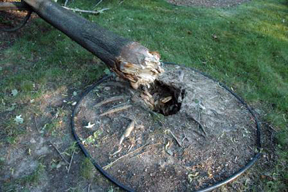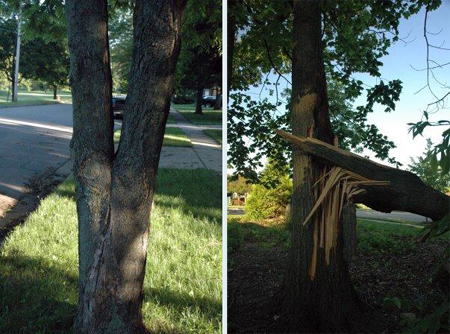June 2013
The National Parks Board (NParks) has over the past two years stepped up its ongoing replacement planting programme taking into account shifts in weather patterns in the region. It said that incidents of "tree failure", defined as anything from broken branches to fallen trees, have been caused mainly by bouts of adverse weather conditions rather than maintenance issues. So it is replacing some familiar trees with species that might be less vulnerable to mishap, and also grouping different trees together in some areas, so they can withstand bad weather.
NParks Tree Maintenance Programme
What Are Some Signs Of Tree Failure?
- Termite trails
- Constrained root growth or trees planted too deep
- Gaping holes or cracks in trunks, especially at soil level
- Excessive fungi, vine, creeper or parasitic plant growth resulting in cavities and decay
- Splintering branches or V-shaped forks in trunks
- Bark has mostly fallen off, exposing smooth wood underneath
- Trees or branches that are bleached, leafless or non-flowering unlike those around them
- Reclining, knobbly or curved trunks
It helps if you speak softly when in nature reserves so that you don't scare away all the fauna before you come to them... ;)
Are There Any Types Of Trees Which Are More Prone?
while retaining most of the existing trees and vegetation...
- If you are going to a wooded area or walking/parking beneath a tree, observe for signs of tree failure.
- Do not go into a wooded area immediately after heavy rain and strong winds.
- Report likely signs of tree failure to NParks at 1800-471-7300.
Sources
- "Four killed, 62 injured by fallen trees over last 10 years: Khaw" (13 May 2013). Channel NewsAsia. Retrieved from http://news.xin.msn.com/en/singapore/four-killed-62-injured-by-fallen-trees-over-last-10-years-khaw (04 June 2013).
- "How Do You Know a Tree Limb Is About to Fall?" by Miriam KRAMER (17 May 2012). Popular Mechanics. Retrieved from http://www.popularmechanics.com/outdoors/survival/tips/how-do-you-know-a-tree-limb-is-about-to-fall-8922559 (04 June 2013).
- "How many trees are there in Singapore?" (22 June 2008). ASK!, National Library Board. Retrieved from http://blogs.nlb.gov.sg/ask/children/566 (02 June 2013)
- "How to Recognize and Prevent Tree Hazards" by Larry TANKERSLEY. Agricultural Extension Service, The University of Tennessee. Retrieved from http://www.nwcg.gov/branches/pre/rmc/htsc/toolbox_assessment/how_to_id_tree_hazards.pdf (03 June 2013, Expired as of 2014).
- "How To Recognize Dead Wood" by Jonathan LANDSMAN. Trees & Shrubs, Home, About.com. Retrieved from http://treesandshrubs.about.com/od/pruning/a/recognizing-dead-wood-in-trees-and-shrubs.htm (04 June 2013).
- "NParks' Tree Management programme" (01 January 2013). National Parks Board. Retrieved from http://www.nparks.gov.sg/cms/index.php?option=com_news&task=view&id=154&Itemid=50 (02 June 2013).
- "Riding the storm out: Observe tree failures and prevent them for the future" by Bert CREGG (25 June 2010). Departments of Horticulture and Forestry, Michigan State University Extension. Retrieved from http://msue.anr.msu.edu/news/riding_the_storm_out_observe_tree_failures_and_prevent_them_for_the_future (03 June 2013).
- "Some tall trees being replaced" by HOE Pei Shan (21 May 2013). Motoring News, ST Cars. Retrieved from http://www.stcars.sg/guides-articles/motoring-news/some-tall-trees-being-replaced/a/119691 (04 June 2013, Expired as of 2014).
- "Some tall trees being replaced to reduce risks" by HOE Pei Shan (19 May 2013). Straits Times Online. Retrieved from http://www.straitstimes.com/breaking-news/singapore/story/some-tall-trees-being-replaced-reduce-risks-20130519 (02 June 2013).

































